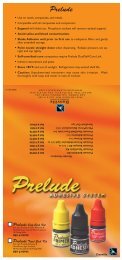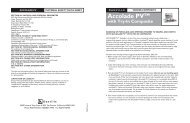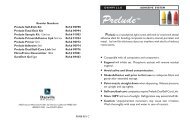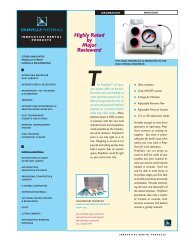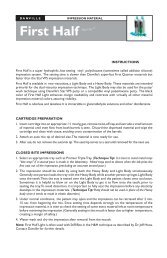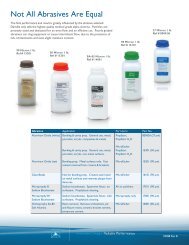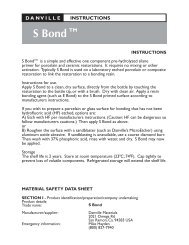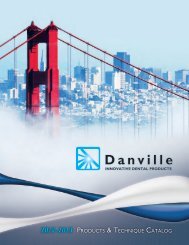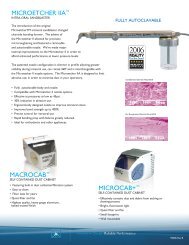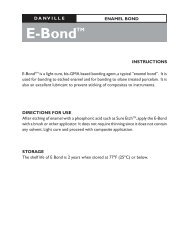MSDS - Danville Materials
MSDS - Danville Materials
MSDS - Danville Materials
You also want an ePaper? Increase the reach of your titles
YUMPU automatically turns print PDFs into web optimized ePapers that Google loves.
TURBO TEMP 2 PROVISIONAL COMPOSITE TURBO TEMP 2 MATERIAL SAFETY DATA SHEET<br />
2. Immediately reset the temp in the mouth and wait 1 or 2 more minutes for the completion of cure.<br />
3. Remove again, wait 4-5 minutes, and pop the temp out of impression.<br />
4. Trim margins with a diamond (it is now rigid).<br />
5. Cement in place, using a non-eugenol temporary cement.<br />
B. Non-Cementation Method<br />
1. Leave Turbo Temp in the mouth during the initial insertion for 2 ½ minutes. It will shrink to fit.<br />
It is recommended to cut an escape route in the facial surface of the impression. This will allow<br />
excess Turbo Temp to escape, thereby reducing flashing.<br />
2. Remove impression from mouth; the temporary should remain in the mouth.<br />
3. Trim excess with the scalpel blade or a diamond bur if necessary.<br />
Note: Some non-cemented Turbo Temp restorations may turn dark after two weeks. To avoid this,<br />
either place permanent restoration within two weeks or cement the temporary restoration.<br />
Turbotemp 2 bridge fabrication:<br />
Three units is the recommended maximum span. To add strength the proximals of posteriors, the<br />
connector areas should be modified to add bulk, prior to taking the preliminary impression. In the<br />
posterior, both buccal and lingual can be modified. In the anterior, most of the modification would be<br />
done on the lingual to preserve esthetics. The preferred block-out material is Ultradent Blue Bolckout,<br />
but soft wax can also be used.<br />
MATERIAL SAFETY DATA<br />
SECTION 1 - PRODUCT IDENTIFICATION<br />
Company Name: <strong>Danville</strong> <strong>Materials</strong><br />
3420 Fostoria Way Suite A-200<br />
San Ramon, CA 94583<br />
Phone (925)973-0710<br />
Fax: (925) 973-0764<br />
Prepared: December 19, 2011<br />
SECTION II - HAZARD(S) IDENTIFICATION<br />
OSHA Permissible Exposure Limits: None<br />
Other Exposure Limit Used: None<br />
ACGIH Threshold Exposure Limit: None<br />
Chronic, Other: None<br />
SECTION III - COMPOSITION/INFORMATION ON INGREDIENTS<br />
Hazardous component % by weight:<br />
Multifunctional Methacrylates 30-40<br />
Malyonlurea Derivative Trace<br />
Silica Filler 45-50<br />
Polyvinyl esters 5-10<br />
Reinforcement can also be used in addition:<br />
Take the preliminary impression. Then place a piece of Ribbond or some other fibers, from mesial to<br />
distal, using cured flowable composite to hold it on preps. The entire piece of reinforcement should<br />
be infused with flowable composite. A figure 8 configuration might be considered. No bonding is used<br />
so that the reinforcement will be retrievable with the temporary restoration. In the usual manner,<br />
form the Turbotemp 2 over the reinforcement. Do not disturb the oxygen inhibited outer layer on<br />
the flowable so the Turbotemp 2 will adhere directly to it.<br />
Trouble Shooting<br />
• When starting with a new cartridge, discard the first pea size amount dispensed through the mixing<br />
tip to ensure even mixing.<br />
• Do not remove the mixing tip after each use. Wait until ready to use it again, then install new<br />
tip. This will prevent catalyst contamination possibly resulting in a plug.<br />
• Mount the mixing tip in proper alignment. Note that the tips are notched to indicate the proper<br />
alignment on the cartridge. By forcing the tip, it can be mounted backwards, resulting in non-setting<br />
mixes. (The two sides of the mixing tip have different size bores.)<br />
• A slightly gummy air inhibited layer will remain on the hardened surface of the temporary. This<br />
layer allows bubble and margin defects to be minimized by directly bonding with a flowable composite<br />
such as StarFlow. The layer is easily removed with ethyl alcohol.<br />
• Exposure to temperatures below 74 0 F will extend the setting time of Turbo Temp. Set times are<br />
based on room temperature material. Refrigeration greatly retards set times.<br />
• Normally there is no need for occlusal adjustments if vinyl polysiloxane is used.<br />
• Before placing a new mix tip, extrude a small amount of material to insure both sides are flowing.<br />
Waste a pea size amount of material immediately before use to insure a full mix.<br />
90346 REV E<br />
SECTION IV - FIRST AID MEASURES<br />
Primary Routes of Exposure: Skin, ingestion<br />
Signs of Exposure: Severe skin or eye irritation, redness or burning sensation.<br />
Ingestion may cause nausea.<br />
Medical Conditions Generally Aggravated by Exposure: Allergies to methacrylates.<br />
First Aid Procedures: For Skin - Wash off infected area with soap and water. For<br />
Ingestion -Seek medical advice, carry container with label and <strong>MSDS</strong>. For Eyes - Rinse<br />
immediately with plenty of water and consult physician .<br />
SECTION V - FIRE-FIGHTING MEASURES<br />
Flash Point: >100 O C<br />
Extinguishing Media: Carbon dioxide, foam, dry chemical<br />
Special Fire Fighting Procedures: None<br />
Flammable limits: ND<br />
Unusual Fire and Explosion Hazards: Polymerizes upon heating.<br />
SECTION VI - ACCIDENT RELEASE MEASURES<br />
None<br />
SECTION VII - HANDLING AND STORAGE<br />
Spill Management: Use absorbent to collect the material. Wash contaminated surfaces with<br />
soap and water.




